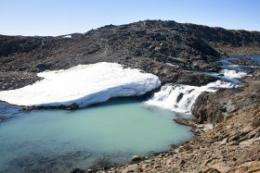Divide the Antarctic to protect native species, propose experts

An international team of scientists have published the first continent-wide assessment of the Antarctic's biogeography, and propose that the landmass should be divided into 15 distinct conservation regions to protect the continent from invasive alien species. The team's findings are published in Diversity and Distributions, while the authors' proposals were outlined today at a lecture to the Antarctic Treaty Consultative Meeting (ATCM) in Hobart, Tasmania.
The study, led by Australian Antarctic Division terrestrial biologist Dr Aleks Terauds, examined the geography, geology, climate, flora and fauna of the ice-free areas of Antarctic and used the results to identify biologically distinct Antarctic Conservation Biogeographic Regions.
This is the first continent-wide assessment of the biogeography of Antarctica using all of the available biodiversity data. Dr Terauds presented the team's findings at the prestigious Scientific Committee on Antarctic Research (SCAR) lecture in Tasmania.
"Previously terrestrial Antarctica has been divided into two main areas based on aspects like geography geology or specific types of biodiversity," Dr Terauds said. "The new research amalgamated 38,000 terrestrial records including the diverse biology such as microbes, invertebrates and plants."
"It revealed a complex ecosystem which can be divided into 15 very distinct and potentially delicate biogeographic regions which are characterised by different climates, landscapes and species," Dr Terauds said.
Invasive species are identified as one of the biggest threats to Antarctic terrestrial ecosystems, particularly in a warming climate. Over 40,000 people are expected to visit Antarctica over the summer, as tourists, scientists or station support personnel. The rise in visitor numbers increases the potential for more species being accidently transferred to and within Antarctica.
"While quarantine procedures are already in place for inter-continental travel, such as cleaning clothing and equipment before arriving in Antarctica, there are less biosecurity measures for intra-continental movement," said Dr Terauds. "The Antarctic Conservation Biogeographic Regions represent an important basis for biosecurity measures to manage the risk of species, including species native to Antarctica, being transferred from one biogeographic zone to another."
The collaborative effort, which involved scientists from Australia, South Africa, New Zealand and the UK, identified the 15 areas as:
- North-east Antarctic Peninsula
- South Orkney Islands
- North-west Antarctic Peninsula
- Enderby Land
- Dronning Maud Land
- East Antarctica
- North Victoria Land
- South Victoria Land
- Transantarctic Mountains
- Ellsworth Mountains
- Marie Byrd Land
- Adelie Land
- Ellsworth Land
- South Antarctic Peninsula.
More information: Aleks Terauds, Steven L. Chown, Fraser Morgan, Helen J. Peat, David J. Watts, Harry Keys, Peter Convey, Dana M. Bergstrom, ‘Conservation biogeography of the Antarctic’, Diversity and Distributions, Wiley-Blackwell, May 2012, DOI: 10.1111/j.1472-4642.2012.00925
Journal information: Diversity and Distributions
Provided by Wiley



















